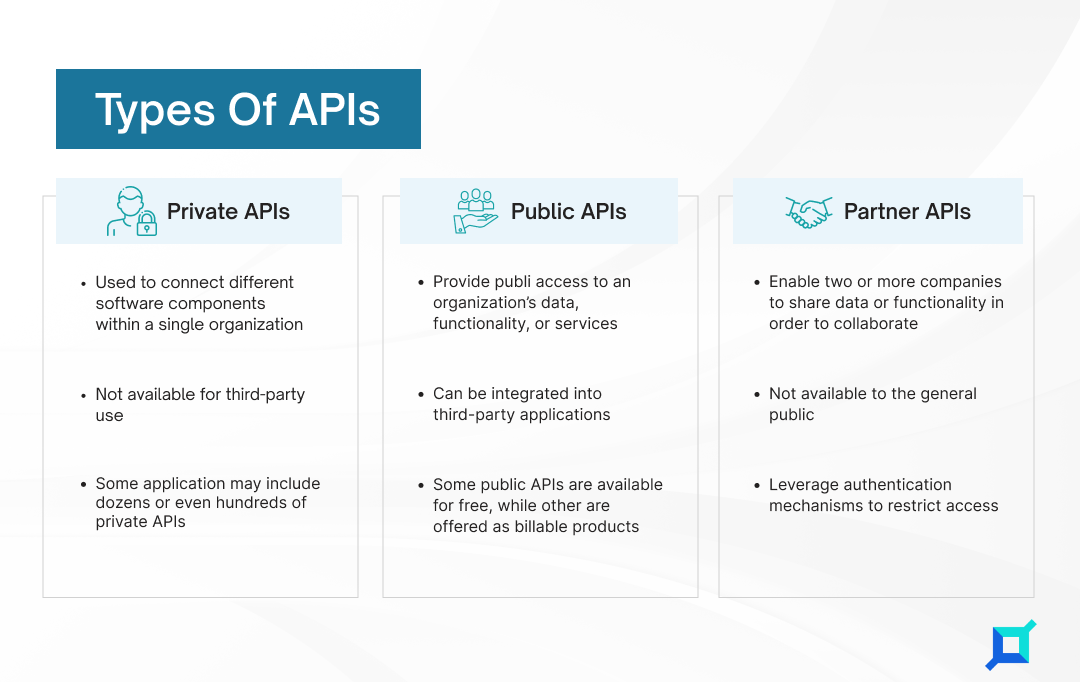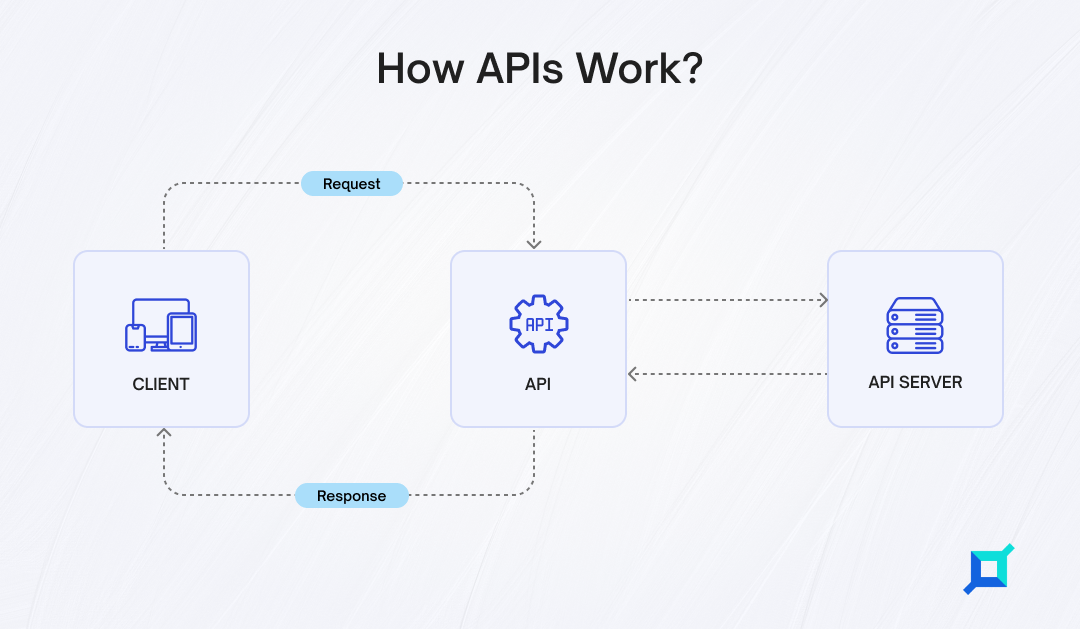In the ever-evolving landscape of technology, APIs (Application Programming Interfaces) have emerged as essential components that power the seamless integration and interaction between various software applications.
Did You Know?
- As per MarketsandMarkets, the API management market is projected to be worth $13.7 billion by 2027, at a CAGR of 25.1% over 2022-2027.
- 57% of web apps are fueled by Application Programming Interfaces (APIs).
APIs play a crucial role in enabling different applications to communicate, share data, and perform actions in a standardized and efficient manner. Whether you’re a developer, business owner, or simply curious about the tech world, understanding APIs and their nuances is becoming increasingly important.
This article aims to provide a comprehensive overview of APIs, covering what is an API, types, use cases, and a lot more that you need to know about APIs.
Introduction to APIs
An Application Programming Interface is basically a set of protocols, routines, and tools that enable various software apps to communicate and interact with each other. It serves as an intermediary that enables the exchange of data and functionality between various software components, even if they were developed by different teams or organizations.
Think of an API as a waiter at a restaurant. The waiter takes your order, conveys it to the kitchen, and brings you the food once it’s ready. You don’t need to know the intricacies of how the kitchen operates; the waiter (API) abstracts that complexity and presents you with a convenient interface to get what you want.
Exploring API Types: Private, Partner & Public APIs

In the realm of software development and application integration, APIs (Application Programming Interfaces) come in various types, each catering to specific needs and audiences. Understanding these API types—Private, Partner, and Public—sheds light on how different software systems collaborate and communicate. Let’s delve into each type to gain a comprehensive understanding.
1. Private APIs
Private APIs, also known as Internal APIs or Internal Private APIs, are designed for use within a specific organization or company. These APIs are not disclosed to external developers or the public; their main purpose is to facilitate communication and data sharing between different components or services within the organization’s ecosystem. Private APIs play a crucial role in streamlining internal processes, improving efficiency, and ensuring consistent interactions between various software applications.
For example, a company might have a private API that allows its web application to communicate with its internal database, enabling seamless data retrieval and updates without exposing sensitive information to the outside world.
2. Partner APIs
Partner APIs are APIs that are selectively shared with trusted third-party developers or organizations. These APIs are intended to enable collaboration and integration between different companies or entities, fostering mutually beneficial partnerships. Partner APIs often require authentication and authorization to ensure that only authorized partners can access and utilize the provided functionalities.
An illustrative example of a partner API is a payment gateway that collaborates with e-commerce platforms. The payment gateway’s API allows the e-commerce platform to securely process transactions on its website while maintaining the integrity of sensitive payment information.
3. Public APIs
Public APIs, also referred to as External APIs or Open APIs, are designed to be accessible by external developers, businesses, and the general public. These APIs are meant to provide developers with a standardized way to access specific features, data, or services offered by a company or platform. Public APIs enable third-party developers to create applications, tools, or integrations that can enhance the functionality of the original platform.
A prime example of a public API is the Google Maps API, which enables developers to embed interactive maps into their applications, websites, or services. This empowers a wide range of developers to enhance their offerings with location-based functionalities without having to reinvent the wheel.
API Working: A Closer Look Into How APIs Facilitate Software Communication

In the modern digital landscape, where a plethora of applications and services collaborate seamlessly to provide a wide range of functionalities, the role of APIs (Application Programming Interfaces) is paramount. APIs serve as the backbone of this interconnected world, enabling different software components to communicate, exchange data, and perform actions effectively. To understand how APIs work, let’s delve into the intricacies of their functioning.
1. Request & Response
At its core, an API operates on a simple principle of request and response. Imagine you are at a restaurant. You don’t need to know how the kitchen works or how the food is prepared. Instead, you interact with the waiter (analogous to an API) by placing an order (making a request). The waiter takes your order to the kitchen, where the chefs prepare the food (perform an action). Finally, the waiter brings your food back to you (sends a response), and you enjoy your meal.
2. Protocol & Format
APIs use a specific protocol (set of rules) and data format to communicate. The most common protocol used is HTTP (Hypertext Transfer Protocol), which is the foundation of the World Wide Web. APIs also use data formats like JSON (JavaScript Object Notation) or XML (Extensible Markup Language) to structure the data being exchanged between applications.
3. Endpoints
APIs expose specific endpoints, which are URLs that correspond to different functions or resources offered by the API. These endpoints represent actions that can be requested from the API. For instance, in a weather API, endpoints could include fetching current weather data or forecasts for specific locations.
4. HTTP Methods
APIs utilize different HTTP methods to perform actions on resources. The most common methods are:
- GET: Used to retrieve data from the server.
- POST: Employed to send data to the server, often to create new resources.
- PUT: Utilized to update existing resources with new data.
- DELETE: Used to remove resources from the server.
5. Authentication & Authorization
To ensure secure and controlled access, APIs often require authentication and authorization. Authentication verifies the identity of the requester, while authorization determines whether the requester has the necessary permissions to perform the requested action. This is crucial to protect sensitive data and prevent unauthorized access.
6. Rate Limiting
API providers often implement rate limiting to prevent abuse and ensure fair usage. Rate limiting confines the number of requests a user or app can make within a specific timeframe. This prevents a single user or application from overwhelming the API server with excessive requests.
7. Responses & Status Codes
When an API receives a request, it processes the action and sends back a response. Responses typically include a status code that indicates whether the request was successful or encountered an error. Common status codes include 200 (OK), 404 (Not Found), and 500 (Internal Server Error).
8. Versioning
As APIs evolve and undergo changes, maintaining backward compatibility becomes important. API versioning allows developers to specify which version of the API they are interacting with, ensuring that their applications continue to work as expected, even as the API’s functionality evolves.
In summary, APIs serve as intermediaries that enable different software systems to communicate and collaborate effectively. By following specific protocols, utilizing endpoints, and adhering to authentication and authorization mechanisms, APIs facilitate the seamless exchange of data and actions between applications. Whether you’re browsing social media, ordering a ride-share, or checking the weather, APIs are functioning behind the scenes to make it all happen seamlessly.
Infrablok Unleashing Innovation With APIs: Your Gateway To Limitless Possibilities!
APIs (Application Programming Interfaces) have revolutionized the way software applications interact, enabling a wide range of use cases across different industries. Here are a few API use cases that demonstrate the versatility and power of APIs in enhancing user experiences, streamlining processes, and fostering innovation.
Moreover, if you’re ready to harness the potential of APIs, look no further than the expertise of the Infrablok technical team. Our professionals are poised to guide you through the dynamic world of APIs, including the API use cases stated below, ensuring your digital endeavors resonate with seamless integration and boundless possibilities.
Third-Party Integrations
One of the most common use cases for APIs is integrating third-party services or functionalities into existing applications. APIs let developers extend the capabilities of their applications without building everything from scratch. For instance, an e-commerce website can integrate a payment gateway API to handle secure transactions, a social media API to enable sharing, and a mapping API to display location information.
Mobile App Development
APIs play a pivotal role in mobile app development by enabling apps to interact with backend servers and access data or services. From retrieving user profiles to sending push notifications, APIs allow apps to offer dynamic and personalized experiences. For instance, a weather app might use a weather data API to provide real-time forecasts and updates to users.
Cloud Services
Cloud computing relies heavily on APIs to provide on-demand access to various resources and services. These APIs enable developers to manage virtual machines, storage, databases, and more without having to worry about the underlying infrastructure. Microsoft Azure and AWS are prime examples of cloud platforms offering extensive APIs.
Social Media Integration
APIs from popular social media platforms like Facebook, Twitter, and Instagram allow developers to integrate social media functionalities into websites and applications. Users can log in utilizing their social media accounts, share content, retrieve user data, and even post updates—all through API interactions.
Internet of Things (IoT)
IoT devices communicate with each other and the internet using APIs. Whether it’s a smart thermostat adjusting the temperature or a fitness tracker synchronizing data to a mobile app, APIs facilitate seamless communication between devices and applications.
Financial Services
APIs have transformed the financial sector, enabling online banking, payment gateways, and fintech innovations. Banking APIs allow users to check balances, transfer funds, and even apply for loans through mobile apps. Payment APIs like PayPal and Stripe simplify online transactions for businesses and consumers alike.
Healthcare Solutions
Healthcare APIs facilitate interoperability among different healthcare systems and applications. Electronic Health Record (EHR) APIs enable secure sharing of patient data between medical facilities, improving patient care and reducing duplication of tests.
E-Commerce
E-commerce platforms leverage APIs to offer seamless shopping experiences. Product search, inventory management, order processing, and payment processing are often handled through APIs.
Wrapping Up
APIs have emerged as the unsung heroes driving modern technological advancements. We cannot overstate how valuable they are in facilitating seamless integration, enhancing user experiences, and launching innovation across industries. From empowering mobile apps to revolutionizing e-commerce, APIs have redefined how software components communicate and collaborate.
Are you ready to unlock the full potential of APIs for your business? Contact us today at Infrablok. Our seasoned experts are primed to guide you through the dynamic landscape of APIs, ensuring that your digital journey is marked by efficiency, innovation, and success.





